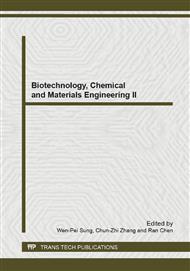p.939
p.943
p.947
p.951
p.955
p.959
p.962
p.967
p.971
Study on the α-Glucosidase Inhibitory Activity of Limonium bicolor Kuntze
Abstract:
The antidiabetic activities of the extracts with different solvents and methods from Limonium bicolor Kuntze were investigated. It was found that all the extracts with ethanol, petroleum ether, EtOAc, n-BuOH and H2O from the underground part of the plant possessed the α-Glucosidase inhibitory activity, and the fractions from the 80% ethanol extracts possessed strong activity. The extracts eluted with water from the 80% ethanol crude extract of the aerial part of the plant were inactive to α-Glucosidase inhibition, the other extracts from the aerial part all give potent α-Glucosidase inhibition activity.
Info:
Periodical:
Pages:
955-958
Citation:
Online since:
January 2013
Authors:
Keywords:
Price:
Сopyright:
© 2013 Trans Tech Publications Ltd. All Rights Reserved
Share:
Citation:


